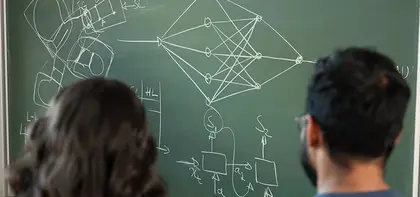
Applied Analysis
The main focus of this group is on rigorous applied mathematics, mainly involving partial differential equations and the calculus of variations. We bridge several mathematical sub-disciplines by applying methods originally developed for differential geometry (Gromov) to fluid dynamics and nonlinear elasticity.
Open positions for PhD students/postdocs
There are open positions for PhD students and postdocs in our group at the Max Planck Institute:
Research
Our work impacts long-held beliefs on so-called weak solutions to the fundamental equations of continuum mechanics, like Euler’s equation for incompressible or compressible fluids. Previously, the notion of weak solutions was seen as a convenient relaxation of classical solutions, closer to the physical conservation laws of mass and momentum. Our work established that weak solutions are under-determined to a dramatic degree: Any closure model for the Reynold’s stress can be approximated by exact weak solutions to Euler’s equation.
We applied this theory to underpin Onsager’s vision that the relevant dissipative – and thus weak – solutions of Euler’s equation have a very specific roughness, namely a third of a spatial derivative. We proved that there is indeed an abundance of strictly dissipative solutions to Euler’s equation of this borderline behavior. We did so through an ingenious multi-scale construction based on an elementary flow pattern. On the other hand, we drew an analogy to an isometric embedding problem from classical differential geometry with its transition from rigidity (Herglotz) to floppiness (Nash). In fact, as opposed to fluid dynamics, the critical exponent in this paper crumpling problem is unknown, and we provide promising contributions to narrowing down the range.
We have validated this approach in diverse applications like the microstructure generated by the density-driven instability in a two-phase porous medium flow, or the microstructure emerging from a vortex sheet. Recently, we have ventured into magneto-hydrodynamics with its conservation of magnetic helicity alongside the dissipation of energy. Our research can be seen as a multi-pronged contribution to a rational mechanics of oscillations and evolving microstructure (Tartar).
News
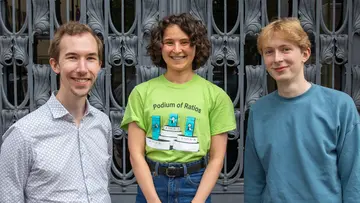
Meet Our New PhD Representatives Meet Our New PhD Representatives

Martina Zizza Martina Zizza
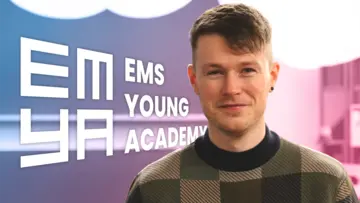
Patrick Heslin appointed to EMYA Patrick Heslin appointed to EMYA
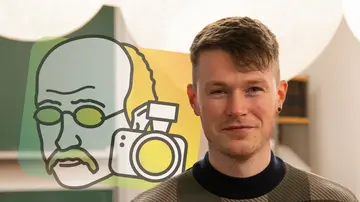
Patrick Heslin Patrick Heslin
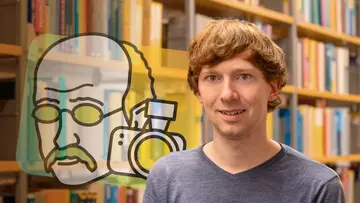
Sebastian Bürger Sebastian Bürger

Antonio Hidalgo Antonio Hidalgo
Members
László Székelyhidi
Pritpal Matharu
Jan Burczak
Jonas Hirsch
Bernd Kirchheim
Publications
Coexistence of two equilibrium configurations in two-dimensional turbulence
In: Physical review fluidsScattering for Schrödinger operators with conical decay
In: Journal of functional analysisTransport of currents and geometric Rademacher-type theorems
In: Transactions of the American Mathematical SocietyWell-posedness of the transport of normal currents by time-dependent vector fields
On the isometric version of Whitney's strong embedding theorem
In: Advances in mathematicsA proof of Vishik's nonuniqueness theorem for the forced 2D Euler equation
In: Journal für die reine und angewandte Mathematik (Crelle's Journal)Unstable vortices, sharp non-uniqueness with forcing, and global smooth solutions for the SQG equation
The double and triple bubble problem for stationary varifolds : the convex case
In: Transactions of the American Mathematical SocietyThe square sticky disk : crystallization and Gamma-convergence to the octagonal anisotropic perimeter
Theory of shifts, shocks, and the intimate connections to
In: Mathematics of computation
Non-uniqueness and inadmissibility of the vanishing viscosity limit of the passive scalar transport equation
In: Journal de mathématiques pures et appliquéesContact discontinuities for 2-D isentropic Euler are unique in 1-D but wildly non-unique otherwise
In: Communications in mathematical physicsEvents
Upcoming Conferences, Workshops, etc.
Hadamard's inequality in the mean Hadamard's inequality in the mean
- Martin Kružík (Czech Academy of Sciences & Czech Technical University, Prague, Czech Republic)
Systematic Search for Singularities and Instabilities in Euler Flows Systematic Search for Singularities and Instabilities in Euler Flows
- Bartosz Protas (McMaster University, Canada)
Gradient integrability for bounded BD-minimizers Gradient integrability for bounded BD-minimizers
- Lisa Beck (University of Augsburg)
to be announced to be announced
- Luis Martínez-Zoroa (University of Basel, Switzerland)

